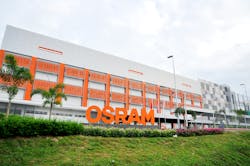Continuing to digest a company that had been nearly four times its size, Austrian sensor maker ams said it is delisting Osram as a separately traded entity, and is seeking €350 million (US$420.5M) in operational savings that will likely include major changes at manufacturing plants as the two outfits hone in on the chip business — including micro LEDs — and continue to sell off Osram’s digital lighting businesses.
Ams, based in Premstaetten, is also changing its name to ams Osram Group, pending shareholder approval at the ams annual general meeting on June 2.
The latest moves come about two months after ams finally gained “domination” status in its acquisition of Munich-based Osram. While ams had gained control of Osram last July after a year or so of trying, it could not exert as much authority over cash and operations until it reached domination under German law.
With domination complete, ams said yesterday it is delisting Osram. It is offering a price of €52.30 ($62.83) per share for the 28% of Osram that it does not own. Osram was trading at €52.60 ($63.19) earlier today. The offer runs for four weeks from May 21 through June 18, after which ams will take Osram off the public traded market, regardless of the uptake to its offer. Munich-based Osram has long been listed on the Frankfurt Stock Exhange’s Xetra system. Ams is listed on the SIX Swiss Stock Exchange.
“This is the next logical step in the full integration of Osram,” ams CEO Alexander Everke said today on a conference call with analysts.
Plenty more changes are afoot, as Everke said that ams is eyeing a total €350M of savings over a three-year period.
“The business integration of ams and Osram is now fully underway, and we are very well on track,” Everke told analysts. “We are running a broad set of parallel programs to implement a new group organization, drive the creation of synergies, and optimize our business portfolio...As part of the announced alignment of our business portfolio, we are already engaged in a number of M&A processes. Here, expect several announcements over the course of this year.”
Ams is trying to sell much of Osram’s digital lighting business, including Internet of Things (IoT) lighting for commercial enterprises. The dismantling began in February, when Osram sold a factory that makes lighting components in Plovdiv, Bulgaria, to San Jose, CA-based contract manufacturer Sanmina.
For now, ams has divided its corporate structure into two groups: semiconductors; and lamps and systems. Semiconductors include the ams stable — optical chips and sensors used in consumer products such as smartphones and in automobiles — and Osram’s optical chip business, which includes LEDs and lasers, and in which micro LEDs is shaping up as a strong future contributor.
Micro LEDs — which are even smaller than the mini LEDs that former Osram CEO Olaf Berlien highlighted in February — will be “highly disruptive for next-generation displays,” Everke said, claiming that ams has “a leading position” in micro LED epitaxy and wafer processing.
“We have a range of major growth vectors for the medium term,” said Everke, drawing attention not only to micro LEDs but also to UV-C LEDs for disinfection purposes, and to next-generation automotive lighting. The auto sector will include high-resolution front lighting, lidar for navigation, and augmented reality that projects images such as information and entertainment displays onto the windshield and thus helps the driver to keep his or her head up (sometimes called head-up displays). Also in the medium term, Everke expressed optimism for consumer digital health applications, and for time-of-flight technologies.
Everke singled out horticultural lighting and mini LEDs as near-term business drivers, among others.
There is enough crossover in many of these fields for ams to perceive €350M in savings over the next three years — €50M ($60.1M) of which has already been achieved since last summer — according to ams CFO and Osram CEO Ingo Bank.
Some of those savings will likely come from changes at the ams and Osram manufacturing plants in the Asia Pacific region, as Bank said the cost assessment “includes evaluation of the manufacturing infrastructure and footprint.”
Asked by one analyst for details on those plans, Bank said ams had not been able to look into the possibilities until it gained domination two months ago, but the evaluation is now underway.
“We now have had the chance to start further looking into what optimization opportunities we have,” Bank said. “If you look at the manufacturing side, [the factories] are largely designed for flexibility so we can do multi-process, multi-products, or multi-technologies in the locations we have across the group in the Asia Pacific.” Those locations include Malaysia — where Osram opened a modern €370M ($444.6M) LED facility in Kulim in 2017 — Singapore and China. The group also runs plants in Germany and Austria and elsewhere, as well as an ams testing center in Calamba City, Philippines.
Whatever decisions the company makes on the manufacturing side, Everke said the acquisition of Osram will benefit ams by greatly expanding its customer reach.
MARK HALPER is a contributing editor for LEDs Magazine, and an energy, technology, and business journalist ([email protected]om).
*Editor’s note: ams reports financials in USD while Osram reports in EUR; currency is provided in both EUR and USD for consistency. Currency is provided at the latest valuation as of time of publication.
For up-to-the-minute LED and SSL updates, why not follow us on Twitter? You’ll find curated content and commentary, as well as information on industry events, webcasts, and surveys on our LinkedIn Company Page and our Facebook page.






